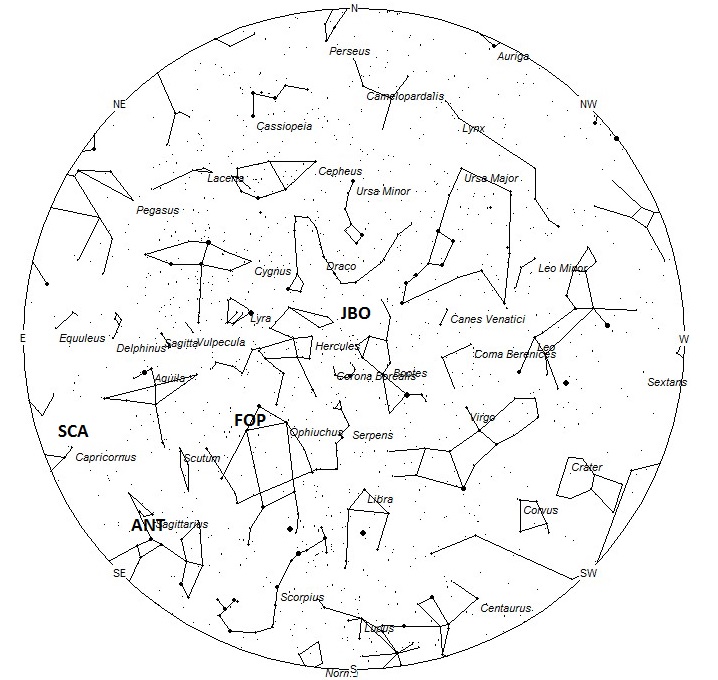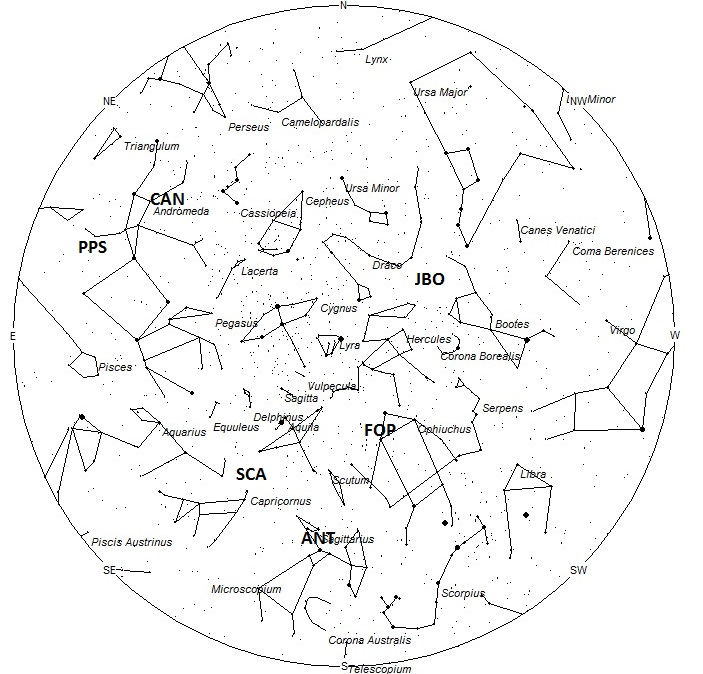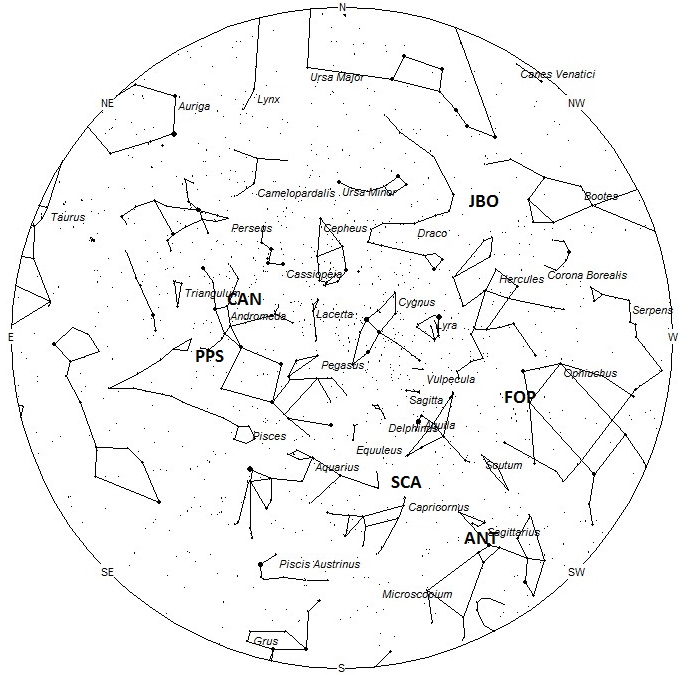Radiant Positions at 0400 Local Summer Time
During this period the moon reaches its last quarter phase on Monday June 27th. At this time the moon will lie 90 degrees west of the sun and will rise between midnight and 0100 local summer time for most sites located in mid-northern latitudes. The half-illuminated moon will interfere with meteor observing, but to a much lesser degree than when near its full phase. Toward the end of the period the waning crescent moon will rise during the late morning hours allowing allowing most of the night to be free of lunar glare. The estimated total hourly meteor rates for evening observers this week is near 3 for observers located in the northern hemisphere and 4 for observers located in tropical southern locations (25S). For morning observers the estimated total hourly rates should be near 9 as seen from mid-northern latitudes (45N) and 12 as seen from tropical southern locations (25S). Morning rates are reduced during this period due to interfering moonlight. The actual rates will also depend on factors such as personal light and motion perception, local weather conditions, alertness and experience in watching meteor activity. Note that the hourly rates listed below are estimates as viewed from dark sky sites away from urban light sources. Observers viewing from urban areas will see less activity as only the brightest meteors will be visible from such locations.
The radiant (the area of the sky where meteors appear to shoot from) positions and rates listed below are exact for Saturday night/Sunday morning June 25/26. These positions do not change greatly day to day so the listed coordinates may be used during this entire period. Most star atlases (available at science stores and planetariums) will provide maps with grid lines of the celestial coordinates so that you may find out exactly where these positions are located in the sky. A planisphere or computer planetarium program is also useful in showing the sky at any time of night on any date of the year. Activity from each radiant is best seen when it is positioned highest in the sky, either due north or south along the meridian, depending on your latitude. It must be remembered that meteor activity is rarely seen at the radiant position. Rather they shoot outwards from the radiant so it is best to center your field of view so that the radiant lies at the edge and not the center. Viewing there will allow you to easily trace the path of each meteor back to the radiant (if it is a shower member) or in another direction if it is a sporadic. Meteor activity is not seen from radiants that are located far below the horizon. The positions below are listed in a west to east manner in order of right ascension (celestial longitude). The positions listed first are located further west therefore are accessible earlier in the night while those listed further down the list rise later in the night.
These sources of meteoric activity are expected to be active this week.
The June Bootids (JBO) are usually a very weak shower that occasionally produces outbursts. Nothing out of the ordinary is expected this year but with the moon out of the way so viewing for unusual activity is warranted. These meteors are best seen from June 23-25, with maximum activity occurring on the 23rd. At maximum the radiant is located at 14:56 (224) +48. This position lies in northwestern Bootes, 15 degrees east of the second magnitude star known as Alkaid (Eta Ursae Majoris). This radiant is best placed in the evening sky just as the sky becomes dark. Observers in the northern hemisphere have a distinct advantage over those located south of the equator as the radiant lies much higher in the evening sky. No matter your location, little activity is expected from this source. With an entry velocity of 13 km/sec., the average June Bootid meteor would be of very slow velocity.
The f Ophiuchids (FOP) were discovered by Sirko Molau and Juergen Rendtel using video data from the IMO network of cameras. These meteors are only active on 3 nights centered on June 30th. Maximum actually occurs on June 29th when the radiant is located at 17:40 (265) +08. This area of the sky is located in central Ophiuchus, 3 degrees north of the 3rd magnitude star known as Celbalrai (beta Ophiuchi). The radiant is best placed near midnight LST when it lies on the meridian and is highest in the sky. Rates of less than 1 per hour are expected, even at maximum. With an entry velocity of 17 km/sec., the average f Ophiuchid meteor would be of very slow velocity.
The center of the large Anthelion (ANT) radiant is currently located at 19:08 (287) -22. This position lies in central Sagittarius, just south of the the twin stars known as pi and omicron Sagittarii. Due to the large size of this radiant, Anthelion activity may also appear from the nearby constellations of Scutum, Serpens Caput, southern Aquila, and western Capricornus as well as Sagittarius. This radiant is best placed near 0100 LST, when it lies on the meridian and is located highest in the sky. Hourly rates at this time should be near 2 as seen from mid-northern latitudes and 3 as seen from tropical southern latitudes. With an entry velocity of 30 km/sec., the average Anthelion meteor would be of slow velocity.
The Sigma Capricornids (SCA) were discovered by Zdenek Sekanina and are active for a month lasting from June 19 through July 24. Maximum occurs on June 27th when the radiant is located at 20:24 (306) -07. This area of the sky is actually located in southeastern Aquila, five degrees north of the naked eye double star Algiedi (Alpha Capricornii). The radiant is best placed near 0300 LST when it lies on the meridian and is highest in the sky. Rates at this time should be near one per hour no matter your location. With an entry velocity of 42 km/sec., the average Sigma Capricornid meteor would be of medium velocity. This velocity is significantly faster than the stronger Alpha Capricornids, which appear from the same general area of the sky during the second half of July.
The Pi Piscids (PPS) were discovered by Dr. Peter Brown in his meteoroid stream survey using the Canadian Meteor Orbit Radar. This shower was later verified by Dr. Peter Jenniskens and David Holman using data from the CAMS network in northern California. These meteors are active from June 11 through July 25 with maximum activity occurring on July 1st. The current position of the radiant is 00:44 (011) +23. This position actually lies in southeastern Andromeda, 2 degrees west of the 4th magnitude star known as eta Andromedae. Rates are currently expected to be less than 1 per hour no matter your location. Rates will increase to near 2 per hour at maximum. With an entry velocity of 68 km/sec., the average Pi Piscid meteor would be of swift speed.
The c-Andromedids (CAN) was discovered by Sirko Molau and Juergen Rendtel using video data from the IMO network. Activity from this source is seen from June 26 though July 20 with maximum activity occurring on July 12. The radiant currently lies at 00:54 (013) +41, which places it in northern Andromeda, close to the faint star known as nu Andromedae. This position is also just 1 degree east of the naked eye Andromeda Galaxy. This area of the sky is best seen during the last dark hour before dawn when the radiant lies highest in a dark sky. Observers in the northern hemisphere are better situated to view this activity as the radiant rises much higher in the sky before dawn as seen from northern latitudes. Current rates would be less than 1 per hour no matter your location. With an entry velocity of 60 km/sec., the average meteor from this source would be of swift velocity.
As seen from the mid-northern hemisphere (45N) one would expect to see approximately 5 sporadic meteors per hour during the last hour before dawn as seen from rural observing sites. Evening rates would be near 2 per hour. As seen from the tropical southern latitudes (25S), morning rates would be near 9 per hour as seen from rural observing sites and 3 per hour during the evening hours. Locations between these two extremes would see activity between the listed figures. Morning rates during this period are reduced due to moonlight.
The list below offers the information from above in tabular form. Rates and positions are exact for Saturday night/Sunday morning except where noted in the shower descriptions.
| SHOWER | DATE OF MAXIMUM ACTIVITY | CELESTIAL POSITION | ENTRY VELOCITY | CULMINATION | HOURLY RATE | CLASS |
|---|---|---|---|---|---|---|
| RA (RA in Deg.) DEC | Km/Sec | Local Daylight Saving Time | North-South | |||
| June Bootids (JBO) | Jun 24 | 14:56 (224) +48 | 18 | 21:00 | <1 – <1 | III |
| f Ophiuchids (FOP) | Jun 30 | 17:40 (265) +08 | 17 | 00:00 | <1 – <1 | IV |
| Anthelions (ANT) | – | 19:08 (287) -22 | 30 | 01:00 | 1 – 2 | II |
| Sigma Capricornids (SCA) | Jun 27 | 20:24 (306) -07 | 42 | 02:00 | 1 – 1 | IV |
| Pi Piscids (PPS) | Jul 02 | 00:44 (011) +23 | 68 | 07:00 | <1 – <1 | IV |
| c-Andromedids (CAN) | Jul 12 | 00:54 (013) +41 | 60 | 08:00 | <1 – <1 | IV |








